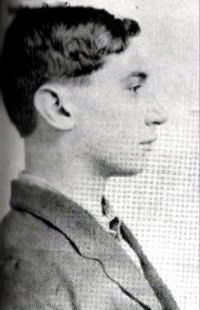
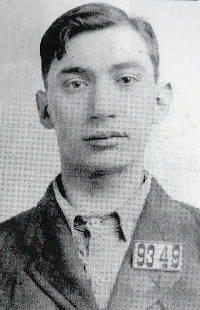
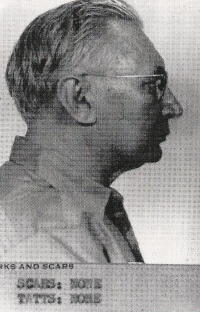
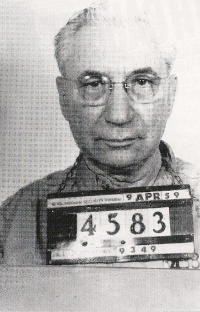
Mugshots of William Holly Griffith in 1915 (top) when he
was sent to Moundsville Pen, and 44 years later in 1959
(Photos courtesy of WV Archives)
By Bob Weaver
One of West Virginia's most infamous murderers was William Holly Griffith (1892-1971) of Creston, Wirt County, sometimes called the "bestial killer." Griffith was incarcerated for killing at
least three people, although he was never convicted for a first episode, the shooting of Creston Constable Jeff Goff in 1915 on "Fish Pot" or Ann's Run. He was issued three life sentences.
WV novelist Davis Grubb said his 1969 novel made into the film "Fools' Parade," staring Jimmy Stewart, was partly based on the life of Griffith.
Grubb also wrote "Night of the Hunter," now listed as one of America's classic film thrillers, is set along the Ohio River. Both films where made on location.
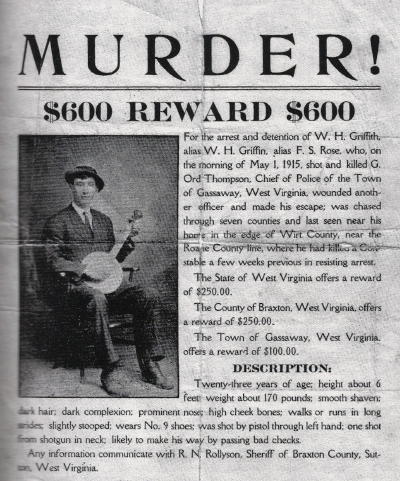
(Courtesy of WV Archives)
Griffith was charged with other murders and folklore made him suspect in other cases around West Virginia and other states, in most of which he was not involved. Over the years, many people in West Virginia came to his defense. His counsel J. Howard Holt, who wrote extensively about the case, believed he was given life sentences for murders he did not commit.
Griffith reportedly continued his killing spree in 1921 after an escape from the West Virginia Penitentiary. A trustee was stabbed to death in a break-out which involved several inmates, and Griffith either committed the murder or took the blame.
During his half-century incarceration he was a likable, docile and a model prisoner, and became one of West Virginia's "graybeard prisoners." He created a business behind the walls, a forerunner to prison industries, and accumulated some wealth through his endeavors.
After attending school in Creston until third grade and growing up in the community, he married Lula Stewart in 1912, and worked as a farmer and construction laborer.
Griffith shot Constable Jeff Goff in Wirt County when he was serving a warrant in 1915. Griffith was twenty-three. The killing was validated by local residents, although the case was never brought to court. Howard Lee, a Wirt County historian and former Attorney General of West Virginia (1925-1933) had little fondness for Griffith and felt he was a dangerous man. Lee wrote about him in his book Looking Backward One Hundred Years In Appalachia, acknowledging Constable Goff was once his neighbor.
"Thomas Boyce, a Justice of the Peace at Creston had issued a warrant for the arrest of Griffith, charging him with a minor offense. He gave the warrant to Constable Goff with directions to arrest Griffith and bring him before the justice for trial."
Lee said his brother, Wirt Lee declined to be deputized to help Constable Goff, stating "I know Holly. He is a well-armed dangerous outlaw who will kill before he will submit to arrest." Lee said Constable Goff replied "I don't need anybody to help me arrest that lad."
Later, Wirt Lee found Goff lying in Griffith's yard. He covered his wounded body with bed clothes from Griffith's bed and left to summon help. Lee and some neighbors removed Goff to his own residence and Dr. Stewart was summoned, who announced nothing could save the injured man. He died one week later.
Griffith took off toward Spencer and caught the Coke and Coal Railroad from Clendenin to Gassaway. One report said two railway policemen saw a man riding between two cars and attempted to stop him, with one officer being shot in the head by Griffith. The State of West Virginia offered a $1000 reward for his capture.
Two Youngstown, Ohio police officers captured Griffith about six weeks later in a diner, after a tip from a waitress. He was returned to Braxton County to be tried and convicted on July 16, 1915 for the killing of the railroad officer. He was sentenced to life in prison.
Charles Park when he was 85 (now deceased) who lived at Newark, Wirt County said Griffith and his father, William Park were long-time friends. The elder Park, while acknowledging the shooting of Constable Goff, never believed Griffith was responsible for the other murders.
Charles Park said he visited Griffith in Moundsville twice about thirty years ago. "They let me right in. We talked about my dad and their friendship. They knew each other well all their lives."
"My dad lost an arm from blood poisoning after his gun exploded because he got snow in the barrel. He was shooting at a fox, and old Dr. Mitchell from Burning Springs sawed his arm off with a hand saw, using whiskey to numb the pain," said Park. "We talked about all that."
Park said Griffith confirmed he and his dad had a visit after his prison escape in 1921. Park quoted his dad saying "The man who Holly Griffith killed at Creston, deserved it," referring to Constable Jeff Goff.
"He had all the reason in the world to kill him. My dad did not believe he killed all those people, although he knew he shot Jeff Goff." Park said his mother was at Griffith's house when the shooting happened.
The 1921 prison escape appeared to be carefully planned and involved four or five other inmates. After setting a fire, Griffith and his associates managed to cut a belt to a dynamo which generated electricity to the prison, dimming the lights around the wall. It was then Griffith's co-conspirators backed out of the escape, and Griffith dropped himself down the thirty foot wall. During the frenzy, a trustee in the engine room interfered with the
escape and was stabbed to death.
J. Howard Holt wrote "Whether Holly or some other (inmate) struck the fatal blow will never be known." Griffith told Holt "These other men are here for a few years and I am here for life, and it makes no difference to me. I will bear the blame."
After Griffith's escape from Moundsville, rumors circulated he had murdered the Sheriff of Taylor County in addition to an old man near Marietta, Ohio at precisely the same time, a hundred miles apart. While the Ohio man was killed, the Sheriff was alive and well.
The killing of Captain Ira Roush, a young boatman on the Ohio River "was at once laid to Holly Griffith's charge," according to attorney J. Howard Holt. Griffith fled to South Carolina, where he was arrested as a suspicious person after a breaking and entering. He was asleep, sitting in a chair, worn from his travels. He was returned and tried for the murder of the trustee killed during the escape.
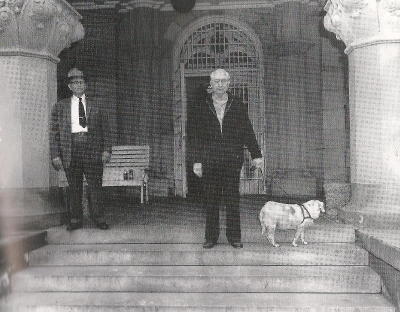
Griffith being transfered to Huttonsville in 1959 with his dog
(Photo courtesy of WV Archives)
J. Howard Holt said the Moundsville warden displayed extreme "hostility"
when obtaining a conviction and another life sentence against Griffith, with
only one person, an inmate, giving testimony against him. The record shows
the convict was immediately pardoned.
Griffith was taken to Mason County to be tried for the murder of the
boatman. Griffith offered no witnesses or defense and the jury found him
guilty of murder in the first degree. He received another life sentence.
Attorney Holt said the case against Griffith was riddled with flawed
evidence, although historian Howard B. Lee was convinced Griffith
committed the murder.
In 1934 Griffith went to work in the prison tailor shop and became an
accomplished tailor, often making uniforms for the West Virginia State
Police and Conservation Commission. He managed to set up his own shop in
the prison and was given special privileges. His prison wealth was
estimated at $40,000, after which the State of West Virginia canceled his
contracts in 1958.
Gov. Hullett Smith gave Griffith a 180 day "medical respite" in 1967 to seek
treatment for what was described as cancer. He was placed under
supervision, residing at his sister's residence in Barberton, Ohio, supposedly
to seek help at the Cleveland Clinic.
Griffith, according to several sources, then purchased an old car and
contacted a prison buddy, and in 1968 they began a tour of America. A
newspaper headlined the story "Holly Griffith, West Virginia's Notorious
Killer on the Loose Again."
Griffith reported he and his prison buddy traveled to the west coast,
stopping in Mexico to get treatment for his cancer, which C. Robert Sarver.
Director of the Division of Correction said was a lie.
During his final escape, historian and former Attorney General Howard B.
Lee, said he remembered Griffith saying he would like to "talk things over
with me." Lee sold his home in Florida. "I was fearful this insane killer might
come to Florida to talk with me," he said. Lee had consistently opposed his
pardon.
Griffith did the unexpected. He returned to the Huttonsville Medium
Security Prison, and asked for money to finance his treatment, knowing full
well he would be locked up again in solitary confinement, although a very
sick man.
Before Griffith died, Calhoun resident Von Yoak led an effort to have him released for prison to come to Calhoun and use his extensive skills to work at the fledgling Rubber Fabricators. That effort failed.
Yoak, who had a personal relationship with Griffith, believed the man was framed for crimes he did not commit.
After lingering with illness, probably prostate cancer, William Holly Griffith
died on July 10, 1971, his unclaimed body was taken to White Gate
Cemetery, the prison burial ground at Moundsville.
After a years of researching this story, I am unclear what really happened to
Holly Griffith. Whether he was the "bestial killer" and serial-like murderer
described by Howard B. Lee, or the victim of a system bent on making him
responsible for several crimes he did not commit. Could the compelling case of
misguided justice detailed by counselor J. Howard Holt be closer to the
truth? Holt said "He is only one example among ten thousand injustices
suffered under our prison system."
Holt concluded his comments on Griffith with this poetry:
"Our crimes against our fellow men outweighs our virtues far,
And hide the good we may have done as black storms hide a star."
"And the darkest blot upon that page, the greatest crime of all,
Is the crime of those who walk erect ... and stand upon the stage."
Charles L. Park, Newark/Creston contributed to Griffith story before his death.
See also William Holly Griffith West Virginia Desperado by Herbert R. Cogar wvculture.org/goldenseal
Read GASSAWAY POLICE CHIEF REMEMBERED - Mortally Wounded By Creston's William Holly Griffith In 1915
There are numerous articles on Griffith secured by Norma Knotts Shaffer under "Moments in Time." You can access them with the Herald SEARCH using the keyword GRIFFITH
NEWSPAPER STORIES FROM THE TIME:
04-15-2002 Griffith to be Tried for Murder in 1915
04-25-2002 Griffith in Headlines Again in 1921
04-09-2002 Wirt Officer Believed Fatally Shot in 1915
04-20-2002 Griffith Continues to Avoid Capture in 1921
04-19-2002 Holly Griffith Escapes Penitentiary in 1921
04-27-2002 Griffith to be Tried for Third Murder in 1921
04-13-2002 Holly Griffith Remains at Large in 1915
04-28-2002 Holly Griffith Trial Postponed in 1921
04-21-2002 Holly Griffith Sightings Abound in 1921
04-10-2002 Holly Griffith Formidable Adversary in 1915
04-14-2002 Holly Griffith's Luck Runs Out in 1915
04-17-2002 Holly Griffith Sentenced to Life in 1915
04-23-2002 Griffith's Murder Trial Delayed in 1921
04-12-2002 Griffith Kills Gassaway Police Chief in 1915
04-11-2002 Goff's Wounds Prove Fatal in 1915
04-22-2002 Griffith Captured - Tells His Tale in 1921
| 


